从游戏化角度解析8种用户类型及其意义
作者:Andrzej Marczewski
Richard Bartle的玩家类型
对于那些尚未听说过Richard Bartle的人,我们有必要在此解释下他所定义的四种玩家类型:
*杀手
*成就者
*社交家
*探索家
以下摘录Bartle原著对这四种玩家类型的简要描述:
玩家使用游戏所提供的工具让其他玩家痛苦(或者帮助他们),这通常包括获得一些武器并在游戏世界中将其运用到其他玩家身上。
所以,我们可以简要概念四种玩家类型:成就者,探索家,社交家和杀手。记住这四者区别的一种简便方法就是将其视为不同的扑克牌:成就者是方块(他们总在寻找宝藏),探索家是黑桃(他们会四处挖掘信息),社交家是红心(他们会同情其他玩家),杀手是梅花(他们会攻击他人)。
对游戏化的比喻
与Richard交流并探索其玩家类型理论的用法之后,我们显然可以看出作为游戏化的比喻,这种方法很有用但不乏缺陷。最重要的是,游戏化与MMOPRG并不相同(游戏邦注:Bartle的玩家类型模式就是针对此类游戏而设计)。在纯粹的游戏中,你的玩家只是想玩。而在游戏化系统中,情况却并非如此。此外,游戏化一般也并不包括玩法。
就我看来,我们需要退后一步,从两种用户类型开始分析,即愿意“玩”和不愿意“玩”这两种类型。我在这里所说的玩,指的是用户乐于同徽章和奖杯等物品互动。对许多人来说,这可能没有多大意义。但这并不意味着你无法创造一个让他们都能融入其中的系统,只是你需要多加思索。
你想玩游戏吗?
从内在激励角度来看,这里有四种基本类型的用户。现在,我们将从外在激励角度扩展至第五种类型:
*玩家(受到外部奖励刺激的用户)
*社交家(因关系而受到激励的用户)
*自由者(因自主权而受到激励的用户)
*成就者(因精通而受到激励的用户)
*慈善家(因意义而受到激励的用户)
这5种用户类型都可能受到我之前提到的四种内在动机或外在奖励之一的影响(详见以下图表):
更详细的用户类型
“玩家”是喜欢在这个系统中获得成就的用户,他们喜欢看到自己的名字出现在积分排行榜上。他们喜欢“游戏”,也最有可能利用“循环漏洞”获得优势。他们属于自成一体的用户类型,喜欢玩游戏以及获得外部奖励。
“社交家”(与Bartle“玩家类型”中的社交家一样)是指那些喜欢与他人互动的用户。他们喜欢与他人产生联系,喜欢这个系统中的社交元素。他们是那些有可能推广你的内部社交网络的群体,多受到社交关系的激励。
“自由者”喜欢掌握自主权,他们不喜欢自己的个人旅程受到约束。他们是最具创意的群体,拥有最迷人的虚拟形象,创造最具个性化的内容,同时也喜欢探索新内容。他们最容易发现系统中的漏洞,追求自我表达和自主权。
“成就者”是指那些希望事事成为第一,或至少在该系统中取得成就的用户。他们希望100%掌握内部学习系统,他们是为自己而如此行事,事后也有可能向他们炫耀自己的成就。他们也可能受到地位的刺激,因为这可以标榜他们的个人成就。他们需要一个可以充实自己,并且令自己的技能炉火纯青的系统。
“慈善家”希望获得一种存在感,向他们施予援手。他们就是那些会在论坛上不厌其烦地解答问题的人,因为这样会让他们觉得自己很有用处。他们需要的是那种可能让自己帮助他人,并获得一种富有意义之感。
用户不会局限于某一类型
那些愿意“玩”的用户可以从属于这五种类型中的一者(或者这五者中任意几个的结合体)。但很显然,他们肯定会属于“玩家”类型。而不愿意“玩”游戏以赢取奖励和攀向积分排行榜的用户,还是可以获得激励和粘性,只是你得更费劲地想出对策,并且意图不可太露骨。也就是说,你仍然可以使用最强大的内在激励方法。
看得出来每一种用户在你的系统中所需要的是不同类型的激励因素。这里要再次强调,这意味着你得想法满足所有人的需求,而不只是那些想要点数和徽章系统的“玩家”(游戏邦注:因为这样只能迎合一小部分用户)。
Richard Bartle建议使用另一种方法具体化内在激励的用户。
为此,我们要忽略“玩家”用户类型,而是将重心投入到内在激励的用户群体。Richard令我了解这些用户类型所遵循的一个简单模式:
*慈善家和自由者都更喜欢在一个自由、无组织的环境中行动。
*成就者和社交家需要身边存在一个组织。
*社交家和慈善家无意从系统中获得任何物质,他们只想要通过与他们互动,或帮助他人中获得一种温馨感。
*成就者和自由者的个人追求程度有所差异。成就者有意提升和获得知识,自由者希望能够创造和使用与自己最匹配的系统。
经过Richard Bartle的建议和经验所调整的用户类型:
这里我意识到自己过于刻板地遵循Bartle所创造的模型,这实际上削弱了我自己的分类法。
各个类型的含义
正如我之前所言,“玩家”是自成一体的类型。从理论上看,你可以通过将玩家与其他4种类型结合产生新类型:玩家成就者、玩家社交者、玩家自由者,玩家慈善者。与所有优秀的系统一样,你可以顾名思义联想到这些用户类型的普遍行为。所以我提出了玩家用户类型的扩展分类:
演变出8种类型
这样我们就得到了8种用户类型,4种内在激励和4种外部激励。下一步就是看看这8种类型在我们的游戏化系统中的普遍行为。这里运用了Bartle原来的坐标轴,事实上我原来避免使用这种方法才是产生诸多问题的原因。它们描述了玩家是否与他人或虚拟世界进行互动。我们可以从两个图表中具体化这一概念。第一个图表描述的是内在激励用户,第二个则是外部激励用户。
*慈善家:通过系统寻找一种意义感(游戏邦注:例如在Quora上回答问题)
*成就者:通过系统获得学习的充实感(例如,在学习系统中成为最擅长完成任务的人)
*社交家:追求与他人的互动和关联(例如,与社交媒介用户进行互动)
*自由者:追求系统中的自主权、探索和创意(例如,环竟、虚拟形象和旅程的定制化服务)
*自我追求者:追求与他人互动而获得的回报(例如,为获得点数而回答问题,数量胜于质量)
*顾客:追求以较少的互动而从系统中获得奖励(例如,忠诚奖励计划)
*人脉者:通过与他人建议联系而增加自己的机会,以期获得将来的回报
*利用者:通过使用系统获得奖励(例如,“赞”Facebook页面而赢得奖励,找到有助于自己获胜的漏洞。
从中可以看出,在玩家用户类型中,就有许多种激励因素形成的交集。顾客和利用者可能存在一些共性,区别在于,利用者会试图找到系统的边界以及它能让自己获益的地方,顾客则只是希望通过较少操作而获得回报。
可能存在的交互行为
在你的系统中,所有这些不同的用户类型都有相互影响的可能性。
例如,慈善家就属于父母形象。他们是那种最可能尽己所能帮助他人,无论他人动机如何的群体。利用者则致力于利用他人,以便从系统中获得个人所需。
社交家和人脉者喜欢与他人互动。这两种人都无意直接通过他人获得什么好处。人脉者的回报来自与他人所建立的关系,社交家的回报则来自对他人的了解,以及与他人的互动。
自我追求者对于在系统中与人互动并没有什么真正的兴趣,他们只是为了获得回报而进行互动。以此类似,成就者也不是为他人而来,他们只是为了实现自我充实感。这两者的区别在于,自我追求者会在系统中搜集徽章和奖励以向他人炫耀自己的技能,他们与Bartle玩家类型中的成就者非常相似。
自由者和顾客对其他用户类型的影响最小。他们纯粹是出于个人兴趣而参与,使用系统获得自己想要的东西。其他用户对这两个群体也没有直接的兴趣。
组合在一起
我将此整合成了一个8种Bartle式玩家类型的3D模型。
如何针对所有用户类型创造平衡的系统
答案就是,这要取决于你系统的目标。如果你返回到我们原来所提出的5种用户类型,玩家、慈善家、社交家、成就者和自由者,这样会更清晰一点。
创造一个吸引4种基本内在激励因素和用户类型。让它具有社交性和意义,并给予人们一些自由。然后,绑定一个精心设计的奖励系统(包含点数,徽章等)。这样,你就不是在创造一个有赖于奖励机制的系统,你可以获得内在激励的用户,以及那些想获得奖励的群体。
下一步就是再深入一点,8种用户类型有助于我们决定如何平衡系统。重要的是记住要尽量获得更多内在激励用户。这些用户重返系统的可能性更大,他们更可能继续制造内容或采取自己之前的行动。
如果这个系统充满自我追求者和利用者,那么你系统中的一切东西都可能会贬值。如果奖励系统很糟糕的话,自我追求者会产生大量无意义的内容,利用者则会生成一些低价值的投票和“赞”。
慈善家和成就者都可以帮助系统茁壮成长。慈善家希望帮助所有人。他们想回答问题并引导用户。成就者则根据系统类型的不同,也可能有同样的追求。他们希望成为某活动中的佼佼者,他们希望为某个问题提供最佳答案,这并不主要是为了帮助他人,而是为了证明自己是最棒的。但是,他们的主要目标是自我修养,如果系统的目标是传授知识,他们也会给予较小的回报。
自由者和顾客给予他人的东西极少,顾客尤其如此。如果充斥太多这两种用户,你的系统就很可能无法有效运转。也许你想要的只是顾客(忠诚计划),但如果你吸引了各种用户类型,就可能获得更大的回报。
社交家是宣传某系统并引进更多用户的绝佳载体,但他们并不像其他用户类型那样善于为系统添加内容。人脉者与此类似,他们动机如何就不重要了。但人脉者会引进任何类型的用户,而不仅仅是与其相关用户。如果充斥太多这类群体,这个系统的社交属性就会被冲淡。看看Twitter上拥有3万“好友”的用户,然后看看这些好友所产生的内容你就知道了。这3万好友与用户可能只是进行了很小的互动,其他用户也不例外。
总结
首先,下图是我针对如何支持不同用户类型这一问题的答案:
另外要说明的是,利用者最可能“作弊”。“作弊”对不同人而言有不同的意思。在这种情况下,我是指那些会“利用”规则中的漏洞(甚至是不择手段,利用他人)以让自己获益的群体。
重要的是,现实生活并不是非黑即白,用户很可能呈现出多种类型的特征。但他们一般都有一个引导自己与他人产生区别的主要特征。随着他们对系统的了解,他们也很可能呈现不同的用户特征。在一个奖励机制运用于刚开始阶段,但在用户上手时逐渐削弱的系统中,你会看到他们从外在“激励”用户转变成内在激励类型。这说明此时用户已经发现这个系统中除了积分和徽章,还有其他更多有意义的内容。(本文为游戏邦/gamerboom.com编译,拒绝任何不保留版权的转载,如需转载请联系:游戏邦)
Gamification User Types
by Andrzej Marczewski
The following blog was, unless otherwise noted, independently written by a member of Gamasutra’s game development community. The thoughts and opinions expressed here are not necessarily those of Gamasutra or its parent company.
Want to write your own blog post on Gamasutra? It’s easy! Click here to get started. Your post could be featured on Gamasutra’s home page, right alongside our award-winning articles and news stories.
Another very misunderstood yet over used metaphor from game design that we use in gamification, is Bartle’s Player Types. What follows is an attempt to create something similar to Richard Bartle’s player types, but for gamified systems.
It should be noted that this was not an exercise in recreating Bartle’s work, or bending his work to fit with gamification – it started as the exact opposite. However, after conversations with Bartle and a little help with the initial categorisation, we have what we have here. Read on!
What’s it all about Richard?
For those that don’t know, Richard Bartle labelled players as one of four types (initially) to help him understand how they interacted with each other and their environments in MMO games (Massively Multiplayer Online). The labels he used were;
Killer
Achiever
Socialiser
Explorer
Quoting straight from the original text, here is a brief explanation of each of these (very, very brief)
Players use the tools provided by the game to cause distress to (or, in rare circumstances, to help) other players. Where permitted, this usually involves acquiring some weapon and applying it enthusiastically to the persona of another player in the game world.
So, labelling the four player types abstracted, we get: achievers, explorers, socialisers and killers. An easy way to remember these is to consider suits in a conventional pack of cards: achievers are Diamonds (they’re always seeking treasure); explorers are Spades (they dig around for information); socialisers are Hearts (they empathise with other players); killers are Clubs (they hit people with them).
If you want to know more, have a look at his original text http://www.mud.co.uk/richard/hcds.htm
A Flawed Metaphor for Gamification
After speaking with Richard and exploring others use of his player type theory (Amy Jo Kim’s Social Player Types is a very good reworking), it becomes obvious that as a metaphor for gamification, it is useful but flawed. At the end of the day, gamification is not the same as MMORPG’s – the thing that Bartle’s Player Types is designed for (and of course works well for!). There is one massive assumption. In pure games, your players WANT to play. In a gamified system, that is not always going to be the case. Also, gamification does not generally include much in the way of gameplay.
As I see it, we need to take a step back and start from just two types of users initially. Those willing to “play” and those not willing to play. Here, when I say play, I mean those who can be engaged with the extrinsic things like badges and trophies. To many, this is of no interest at all. However, that does not mean you cannot create a system that will engage them as well. You just have to think about it.
Do You Want to Play a Game?
Concentrating on the intrinsically motivated users, there are four basic types. For now, we will consider those who are extrinsically motivate as a fifth type, that I will expand on later.
Player (Those motivated by extrinsic rewards)
Socialiser (Those motivated by relatedness)
Free Spirit (Those motivated by autonomy)
Achiever (Those motivated by mastery)
Philanthropist (Those motivated by purpose)
All of these five user types can be strongly influenced (though it does not have to be exclusively) by one of the four intrinsic motivators I have previously mentioned, or by extrinsic rewards.
The diagram below shows how this looks.
My User Types in more detail
Players are the ones who like to get the achievements in your system; they like to see their names on the leaderboards. They like the “game” of it all. They are also the most likely to make use of “loop holes” to gain an advantage. They are a group of user types in their own right, Bartle’s Player Types cover them very well though! There to play the game and are happy with the extrinsic rewards.
Socialisers (as in the original Player Type) are the ones who want to interact with others. They like to be connected to others. They are interested in parts of the system that help them do this. These are the ones will evangelise your internal social networks. Most motivated by the social connections aspects of relatedness.
Free Spirits like to have agency. They don’t want to be restricted in how they go through their personal journey. They will be the most creative, have the fanciest avatars, create the most personal content, but also like to explore. Likely to find the most holes in a system. They seek self expression and autonomy.
Achievers are the ones who want to be the best at things, or at least be achieving things within the system. They want to get 100% on the internal learning system. They do this for themselves and are probably not that bothered with then showing off to others about it. (This differs from the original definition, but I could not think of a better word!!). May also be motivated by status as a representation of thier personal achievment They need a system that will enrich them and lead them towards mastery.
Philanthropists want to feel that they are part of something bigger. They want to give back to others. These are the ones who will answer endless questions on forums, just because they like to feel they are helping. They want a system that allows them to enrich others and feel a sense of purpose.
There Can be More than One
As you can see, those willing to “play” can fall into any one of the five categories (or any combination of the five). However (obviously), they are the only ones who will fall into the player type. Those who are not willing to play the game of collect the rewards and climb the leaderboard, can still be motivated and engaged, you just have to try harder and be less obvious. That said, if you look at it – you still have the most powerful intrinsic methods available.
It is easy to see that each type of user will need different types of motivation within your system. It goes again to show that you have to cater for everyone, not just the players with a points and badges system. This is likely to cater only for the smallest number of people.
Now, as I said, Richard Bartle offered some advice after reading this, he suggested another way of visualising the intrinsically motivated users.
For this, we will ignore the player user type, concentrating instead on the intrinsically motivated groups. Richard helped me to see that these types follow a simple pattern.
Philanthropists and Free Spirits both prefer to act within a free and unstructured environment.
Achievers and Socialisers tend to need a structure around them.
Socialisers and Philanthropists are not looking to gain anything material from the system. They are there (as Richard describes it) for the warm fuzzy feelings they get from engaging with or giving to others.
Achievers and Free Spirits are there for varying degrees of personal gain. Not in bad way though. Achievers are interested in improving and gaining understanding. Free Spirits want to be able to create and use the system to best suit them.
My User Types, with a dash of Richard Bartle’s advice and experience.
User Types
At this point I realised that in trying so hard to not follow the work that Bartle had already done, I was in fact crippling my categorisations.
What’s in a word?
As I mentioned before, the “player” type is a categorisation in its own right. In theory, you could settle for calling just combining player with any of the other four types, calling them; Player Achiever, Player Socialiser, Player Free Spirit and Player Philanthropists – believe me, I wish I had! However, as with all good systems, it helps to have names you can visualise and connect with behaviours. So, I have come up with the following. Oh and I can’t stress enough – this is not a theory, this is a categorisation.
Creating 8 user types
Then there were Eight
This leaves us with eight user types, four intrinsically motivate and four primarily extrinsically motivated. The next step is to look at what these eight types are acting on, in our gamified system. Bartle’s original axes help here; in fact, it was my effort to avoid using them that was causing me so many problems. They describe whether a player is interacting with or acting on people or the virtual world. This gives us two diagrams to help visualise this. The first describes the intrinsically motivated users, the second the extrinsically motivated.
User Types – Acting on Intrinsic
User Types Acting on Extrinsic
Philanthropists: Seek a sense purpose from a system (e.g. answering questions on Quora, contributing to Wikipedia).
Achievers: Seek enrichment and mastery from the system (e.g. learning systems, being best at tasks).
Socialisers: Seek interactions and relatedness with other people (e.g. engaged social media users).
Free Spirits: Seek autonomy, exploration and creativity in a system (e.g. customisation of environment, avatar, journey).
Self Seekers: Seek rewards from interacting with others (e.g. answering peoples questions just for points. Quantity over Quality).
Consumers: Seek to get rewards from the system with little interaction (e.g. loyalty schemes).
Networkers: Seek to connect to others to increase their profile and the rewards that may bring (e.g. Klout obsessive’s).
Exploiters: Seek to gain reward from using the system, possibly by any means (e.g. liking Facebook pages for prizes, finding the loopholes that help them win).
As you can see, within the Player User types there may well be some crossover of motivation. Consumers and Exploiters may share many of the same traits. The difference is, exploiters will try to find the boundaries of the system and how that may benefit them – consumers just want to get their reward with as little action from them as possible.
Possible Interactions
All of these different user types have the potential to affect each other in your system.
For example, Philanthropists are the parent figure. They are the ones who are likely to want to help anybody they can, no matter of the other person’s motives. Exploiters, on the other hand, will make use of anyone and everything they can to get personal gain from the system.
Socialiser and Networkers will wish to interact with people. Neither will be after anything from people directly. In the case of a networker, their reward comes from being connected; where as the socialiser’s reward is knowing you and interacting with you.
Self Seekers have no real interest in in the people within a system, they are just a means to an end (that end being the shiny shiny things). In a similar way, Achievers are not there for the people, they are there for self enrichment. The big difference here is that the Self Seeker is the one who will collect badges and trophies in a system to show off their expertise to others. The Self Seeker is very similar to the Bartle Achiever player type!
Free Spirits and Consumers have the least impact on any of the other users. Their interests are purely personal, using the system to get what they want from it. Other users are of no direct interest to them.
Putting it together visually
I could call this, making a pretty picture that looks like Bartle’s full eight Player Type model!
All of this can be represented in a sort of ’3D’ / TriDimensional version of our two Acting On diagrams from earlier.
All 8 User Types Visualised
How do you create a balanced system for all types of users?
The answer is, with great difficulty and it depends on the goals of your system. However, if you go back to when we just had five user types, Player and then Philanthropists, Socialisers, Achievers and Free Spirits, it becomes a little clearer.
Create a system that appeals to the four basic intrinsic motivations and user types. Make it social, make it meaningful and give people some freedom. Then, integrate a well thought out reward system (points, badges etc.). If you do it this way around, you are not creating a system that relies on the rewards to run. That way, you get the intrinsically motivated people anyway and those that are there for rewards are catered for.
Next, looking a little deeper, the eight types of users can help us decide how to balance the system. It is important to keep in mind that you want more of the intrinsically motivated users if possible. These are the ones who will keep coming back, keep producing content or whatever else they are meant to be doing.
If the system is flooded with Self Seekers and Exploiters then you stand the chance of devaluing everything. Self Seekers run the risk of generating lots of meaningless content whilst exploiters will reduce the value of things like upvotes and likes if the rewards are badly implemented.
Philanthropists and Achievers can both help a system thrive. Philanthropists want to help everyone. They want to answer questions and guide users. Achievers, depending on the type of system, may also wish to do the same. They are interested in being the best – at mastering things. They will want to give the best answer to a question, not so much to help the user, but to know they were the best. However, as their main aim is self-enrichment, they can also give very little back to as system aimed at teaching – which may be just what you want!
Free Spirits and Consumers tend to give very little back to the people, consumers especially. Too many of either of them and the social aspect of your system stands a good chance of not working. It is possible that consumers are all you want (with a loyalty scheme), but it is worth considering you can get greater value from engaging everyone else.
Socialisers are great for evangelising a system and bringing more people too it, however, they don’t add content to systems as much as other types. Networkers are similar, whatever their motivations may be. However, networkers will bring in anyone, not just relevant people. Too many of them and the social aspect of the system can become diluted. Look at users on twitter with 30,000 “friends” then look at what content these friends actually generate. The likelihood is that of these 30,000 people, they only interact with a tiny fraction – so will other users.
A few final thoughts
First, I was asked if I could give a few ideas on how to support different user types. The image below was my attempt to assist.
Supporting User Types
Also (to satisfy a question I have had), exploiters are the most likely to “cheat”. Now, cheating is different things to different people. In this case, I mean they are the ones who will “exploit” loopholes in the rules to gain – even if it is at the expense of others within the system.
It is really important to keep in mind, this is all here to help clarify thinking. Real life is not as black and white, users will most likely display traits from multiple user types. But, they will usually have one that guides them more than the others. They are also likely to change user types as they get to know the system. In systems where rewards are used in the onboarding process, but are phased out as the user becomes more capable, you will see them going from extrinsically “motivated” user types to intrinsically motivated types. This is when they realise that there is more to be gained from the system than just the points and badges.(source:gamasutra)

























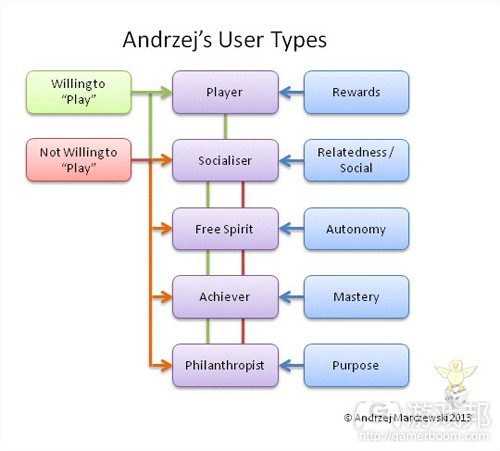
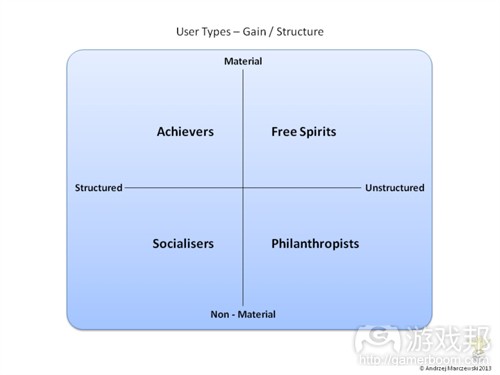
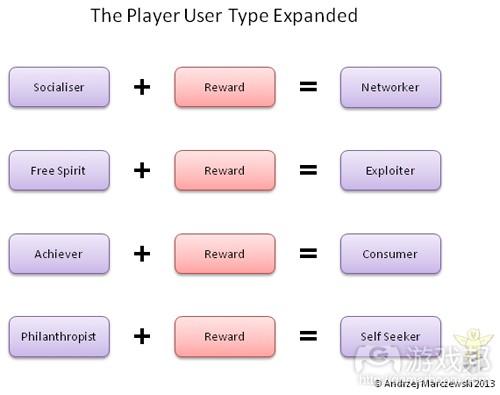

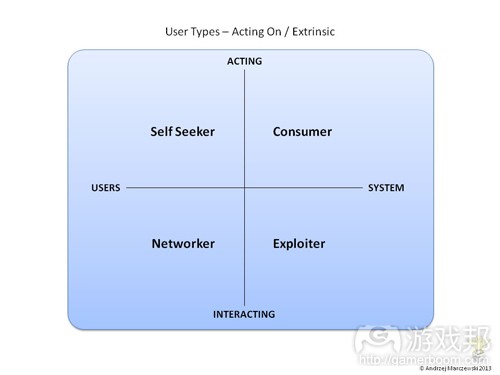
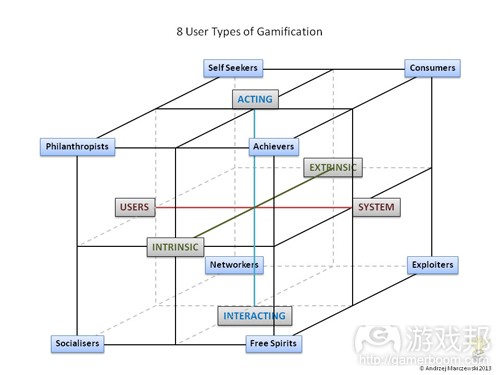















 闽公网安备35020302001549号
闽公网安备35020302001549号